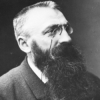Auguste Rodin

Auguste Rodin
François Auguste René Rodin, known as Auguste Rodin, was a French sculptor. Although Rodin is generally considered the progenitor of modern sculpture, he did not set out to rebel against the past. He was schooled traditionally, took a craftsman-like approach to his work, and desired academic recognition, although he was never accepted into Paris's foremost school of art...
NationalityFrench
ProfessionSculptor
Date of Birth12 November 1840
CityParis, France
CountryFrance
What is drawing? Not once in describing the shape of the mass did I shift my eyes from the model. Why? Because I wanted to be sure that nothing evaded my grasp of it... My objective is to test to what extent my hands already feel what my eyes see.
Genius only comes to those who know how to use their eyes and their intelligence.
The artist has only to trust his eyes.
A mediocre man copying nature will never produce a work of art, because he really looks without seeing, and though he may have noted each detail minutely, the result will be flat and without character... the artist on the contrary, sees; that is to say, his eye, grafted on his heart, reads deeply into the bosom of nature.
To any artist, worthy of the name, all in nature is beautiful, because his eyes, fearlessly accepting all exterior truth, read there, as in an open book, all the inner truth.
There are unknown forces in nature; when we give ourselves wholly to her, without reserve, she lends them to us; she shows us these forms, which our watching eyes do not see, which our intelligence does not understand or suspect.
In short, Beauty is everywhere. It is not that she is lacking to our eye, but our eyes which fail to perceive her. Beauty is character and expression. Well, there is nothing in nature which has more character than the human body. In its strength and its grace it evokes the most varied images. One moment it resembles a flower: the bending torso is the stalk; the breasts, the head, and the splendor of the hair answer to the blossoming of the corolla. The next moment it recalls the pliant creeper, or the proud and upright sapling.
Inside you there's an artist you don't know about. He's not interested in how things look different in moonlight.
In front of the model I work with the same will to reproduce truth as if I were making a portrait. I do not correct nature, I incorporate myself into it; it directs me. I can only work with a model. The sight of human forms nourishes and comforts me.
One must work, nothing but work, and one must have patience...
I grant you that the artist does not see Nature as she appears to the vulgar, because his emotion reveals to him the hidden truths beneath appearances.
People say I think too much about women, yet, after all what is there more important to think about?
How painful it is to find that my figure can be of no help to my future... how painful to see it rejected on account of a slanderous suspicion!
If we now seek the spiritual significance of the technique of Michelangelo we shall find that his sculpture expressed restless energy...